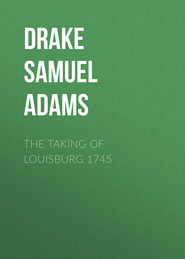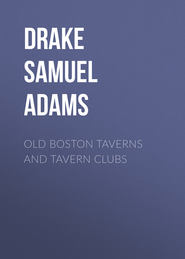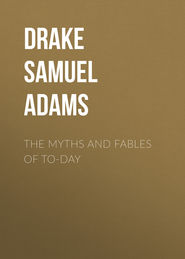По всем вопросам обращайтесь на: info@litportal.ru
(©) 2003-2024.
✖
Nooks and Corners of the New England Coast
Настройки чтения
Размер шрифта
Высота строк
Поля
299
The first bridge spanning what was known as Howland's Ferry was completed in 1795. It was of wood, destroyed and swept to sea by a storm; rebuilt, and again destroyed by worms. The present stone structure was built in 1809-'10, and, though injured by the gale of 1815, stands firm.
300
The battle was fought in the valley below Quaker, sometimes called Meeting-house, Hill. Sullivan commanded in chief, though Greene is entitled to a large share of the credit of repulsing the British attack. It was a well-fought action. Pigot, by British accounts, had six thousand regular troops. Lafayette was mad as a March hare at their fighting without him.
301
Lechford, writing between 1637 and 1641, says: "At the island called Aquedney are about two hundred families. There was a church where one Master Clark was elder: the place where the church was is called Newport, but that church, I hear, is now dissolved. At the other end of the island there is another town called Portsmouth, but no church. Those of the island have a pretended civil government of their own erection without the king's patent."
302
To be exact, the shores adjacent to the rock are in the town of Berkeley, formerly part of Dighton.
303
A copy of the inscription, made by Professor Sewall, is deposited in the Museum at Cambridge. There is another copy, by James Winthrop; see plate in vol. iii., "Memoir American Academy," and description of method of taking it, vol. ii., part ii., p. 126. Many others have been taken, more or less imperfect; the best one recollected is in the hall of the Antiquarian Society, Worcester, Massachusetts.
304
Watch Hill, in the town of Westerly and near Stonington, is the south-western extremity of Rhode Island.
305
Named from Captain Adrian Blok, a Dutch navigator. Its Indian name was Manisses. There are about twelve hundred inhabitants on this island, all native-born, of whom two hundred and seventy-five are voters. There are also six schools, two Baptist churches, and two windmills, a hotel, and several summer boarding-houses. Two hundred fishing-boats are owned by the islanders. In 1636 John Oldham, mentioned in our ramble in Plymouth, was murdered here by the Pequots. Block Island in 1672 was made a township, by the name of New Shoreham.
306
The two forts, Trumbull and Griswold, are named from governors of Connecticut. They date from the Revolution. Fort Trumbull in its present form was completed in 1849, under the supervision of General G. W. Cullum, U. S. A. In passing through New London in April, 1776, General Knox, by Washington's direction, examined the harbor with the view of erecting fortifications, and reported, by letter, that it would, in connection with Newport, afford a safe retreat to the American navy or its prizes in any wind that blew.
307
Son of Governor Winthrop, of Massachusetts. He passed his first winter on Fisher's Island, which remained in his family through six generations. The valuable manuscript collection known as the Winthrop papers was found some years ago on the island, which belongs to New York in consequence of the grants to the Earl of Sterling and the Duke of York. The origin of its present name is uncertain, though so called as early as 1636. Governor Winthrop relates to Cotton Mather a singular incident which happened on Fisher's Island the previous winter. During the severe snow-storms hundreds of sheep, besides cattle and horses, were buried in the snow. Even the wild beasts came into the settlements for shelter. Twenty-eight days after the storm alluded to, the tenants of Fisher's Island, in extricating the bodies of a hundred sheep from one bank of snow in the valley, found two alive in the drift, where they had subsisted by eating the fleeces of those lying dead near them.
308
In 1834 New London employed thirty-six vessels in whaling and sealing. A few are still engaged in the latter fishery, in the extreme navigable waters of the Arctic and Antarctic seas.
309
During the unexampled cold of the past winter (1874-'75), the light-boat off New London was, in fact, carried away from her moorings by an ice-field, and many others all along the coast were stranded.
310
At the light-houses I have visited in cold weather, the unvarying complaint is made of the poor quality of the oil furnished by the Light-house Board. One keeper told me he was obliged to shovel the congealed lard-oil out of the tank in the oil-room, and carry it into the dwelling, some rods distant, to heat it on his stove; sometimes repeating the operation frequently during the night, in order to keep his light burning.
311
It is shown in the view of New London in 1813, at the head of this chapter.
312
Bishop Seabury was born in 1728, and died in 1796, aged 68. In person he was large, robust, and vigorous; dignified and commanding in appearance, and loved by his parishioners of low estate. After consecration he discharged the functions of bishop of the diocese of Connecticut and Rhode Island.
313
The months of January and February, 1875, will be long remembered in New England for the intense and long-continued cold weather. Long Island Sound was a vast ice-field, which sealed up its harbors. For a time navigation was entirely suspended, the boats usually plying between Newport, Stonington, New London, and New York being obliged to discontinue their voyages. Gardiner's Bay was completely closed. The shore of Long Island, on its ocean side, was strewed with great blocks of ice. An unusual number of disasters signalized the ice embargo throughout the whole extent of the New England coast.
314
In all, the British destroyed one hundred and forty-three buildings, sixty-five of which were dwellings, and including the court-house, jail, and church.
315
In the Wadsworth Museum, Hartford, the vest and shirt worn by Ledyard on the day of his death, are still shown to the visitor. Lafayette, when attacking the British redoubt at Yorktown, ordered his men, it is said with Washington's consent, to "remember New London." The continental soldiers could not or would not execute the command on prisoners who begged their lives on their knees.
316
Soon after the surrender a wagon loaded with wounded Americans was set in motion down the hill. In its descent it struck with great force against a tree, causing the instant death of several of its occupants. – "Gordon's Revolution," vol. iv., p. 179.
317
Captain Mason, with the Connecticut and Massachusetts forces, numbering in all only ninety men, together with about four hundred Narragansets and Mohegans, attacked the Pequot fortress on the morning of May 26th, 1637. His Indian allies skulked in the rear. Mason's onset was a complete surprise; but he would not have succeeded had he not fired the fort, which created a panic among the enemy, and rendered them an easy prey to the English and friendly Indians surrounding it. Between six and seven hundred Pequots perished.
318
The English in these early wars fought in armor, that is to say, a steel cap and corselet, with a back and breast piece, over buff coats, the common equipment everywhere of that day for a horse or foot soldier.
319
Mr. John Quincy Adams accompanied his father to France, and was placed at school near Paris.
320
Miss E. S. Quincy's "Memoir."
321
In 1835, when President Jackson demanded twenty-five millions of France on account of French spoliations, the claim of Beaumarchais was allowed, after deducting a million livres which had been advanced by Vergennes. Deane's heirs did not obtain an adjustment of his claims by Congress until 1842.
322
Ledyard proceeded no farther than Cairo, where he died, in 1788, of a bilious fever.
323
Decatur offered to match the United States and Macedonian with the Endymion and Statira. Sir Thomas declined the proposal as made, but consented to a meeting between the Statira and Macedonian alone.
The first bridge spanning what was known as Howland's Ferry was completed in 1795. It was of wood, destroyed and swept to sea by a storm; rebuilt, and again destroyed by worms. The present stone structure was built in 1809-'10, and, though injured by the gale of 1815, stands firm.
300
The battle was fought in the valley below Quaker, sometimes called Meeting-house, Hill. Sullivan commanded in chief, though Greene is entitled to a large share of the credit of repulsing the British attack. It was a well-fought action. Pigot, by British accounts, had six thousand regular troops. Lafayette was mad as a March hare at their fighting without him.
301
Lechford, writing between 1637 and 1641, says: "At the island called Aquedney are about two hundred families. There was a church where one Master Clark was elder: the place where the church was is called Newport, but that church, I hear, is now dissolved. At the other end of the island there is another town called Portsmouth, but no church. Those of the island have a pretended civil government of their own erection without the king's patent."
302
To be exact, the shores adjacent to the rock are in the town of Berkeley, formerly part of Dighton.
303
A copy of the inscription, made by Professor Sewall, is deposited in the Museum at Cambridge. There is another copy, by James Winthrop; see plate in vol. iii., "Memoir American Academy," and description of method of taking it, vol. ii., part ii., p. 126. Many others have been taken, more or less imperfect; the best one recollected is in the hall of the Antiquarian Society, Worcester, Massachusetts.
304
Watch Hill, in the town of Westerly and near Stonington, is the south-western extremity of Rhode Island.
305
Named from Captain Adrian Blok, a Dutch navigator. Its Indian name was Manisses. There are about twelve hundred inhabitants on this island, all native-born, of whom two hundred and seventy-five are voters. There are also six schools, two Baptist churches, and two windmills, a hotel, and several summer boarding-houses. Two hundred fishing-boats are owned by the islanders. In 1636 John Oldham, mentioned in our ramble in Plymouth, was murdered here by the Pequots. Block Island in 1672 was made a township, by the name of New Shoreham.
306
The two forts, Trumbull and Griswold, are named from governors of Connecticut. They date from the Revolution. Fort Trumbull in its present form was completed in 1849, under the supervision of General G. W. Cullum, U. S. A. In passing through New London in April, 1776, General Knox, by Washington's direction, examined the harbor with the view of erecting fortifications, and reported, by letter, that it would, in connection with Newport, afford a safe retreat to the American navy or its prizes in any wind that blew.
307
Son of Governor Winthrop, of Massachusetts. He passed his first winter on Fisher's Island, which remained in his family through six generations. The valuable manuscript collection known as the Winthrop papers was found some years ago on the island, which belongs to New York in consequence of the grants to the Earl of Sterling and the Duke of York. The origin of its present name is uncertain, though so called as early as 1636. Governor Winthrop relates to Cotton Mather a singular incident which happened on Fisher's Island the previous winter. During the severe snow-storms hundreds of sheep, besides cattle and horses, were buried in the snow. Even the wild beasts came into the settlements for shelter. Twenty-eight days after the storm alluded to, the tenants of Fisher's Island, in extricating the bodies of a hundred sheep from one bank of snow in the valley, found two alive in the drift, where they had subsisted by eating the fleeces of those lying dead near them.
308
In 1834 New London employed thirty-six vessels in whaling and sealing. A few are still engaged in the latter fishery, in the extreme navigable waters of the Arctic and Antarctic seas.
309
During the unexampled cold of the past winter (1874-'75), the light-boat off New London was, in fact, carried away from her moorings by an ice-field, and many others all along the coast were stranded.
310
At the light-houses I have visited in cold weather, the unvarying complaint is made of the poor quality of the oil furnished by the Light-house Board. One keeper told me he was obliged to shovel the congealed lard-oil out of the tank in the oil-room, and carry it into the dwelling, some rods distant, to heat it on his stove; sometimes repeating the operation frequently during the night, in order to keep his light burning.
311
It is shown in the view of New London in 1813, at the head of this chapter.
312
Bishop Seabury was born in 1728, and died in 1796, aged 68. In person he was large, robust, and vigorous; dignified and commanding in appearance, and loved by his parishioners of low estate. After consecration he discharged the functions of bishop of the diocese of Connecticut and Rhode Island.
313
The months of January and February, 1875, will be long remembered in New England for the intense and long-continued cold weather. Long Island Sound was a vast ice-field, which sealed up its harbors. For a time navigation was entirely suspended, the boats usually plying between Newport, Stonington, New London, and New York being obliged to discontinue their voyages. Gardiner's Bay was completely closed. The shore of Long Island, on its ocean side, was strewed with great blocks of ice. An unusual number of disasters signalized the ice embargo throughout the whole extent of the New England coast.
314
In all, the British destroyed one hundred and forty-three buildings, sixty-five of which were dwellings, and including the court-house, jail, and church.
315
In the Wadsworth Museum, Hartford, the vest and shirt worn by Ledyard on the day of his death, are still shown to the visitor. Lafayette, when attacking the British redoubt at Yorktown, ordered his men, it is said with Washington's consent, to "remember New London." The continental soldiers could not or would not execute the command on prisoners who begged their lives on their knees.
316
Soon after the surrender a wagon loaded with wounded Americans was set in motion down the hill. In its descent it struck with great force against a tree, causing the instant death of several of its occupants. – "Gordon's Revolution," vol. iv., p. 179.
317
Captain Mason, with the Connecticut and Massachusetts forces, numbering in all only ninety men, together with about four hundred Narragansets and Mohegans, attacked the Pequot fortress on the morning of May 26th, 1637. His Indian allies skulked in the rear. Mason's onset was a complete surprise; but he would not have succeeded had he not fired the fort, which created a panic among the enemy, and rendered them an easy prey to the English and friendly Indians surrounding it. Between six and seven hundred Pequots perished.
318
The English in these early wars fought in armor, that is to say, a steel cap and corselet, with a back and breast piece, over buff coats, the common equipment everywhere of that day for a horse or foot soldier.
319
Mr. John Quincy Adams accompanied his father to France, and was placed at school near Paris.
320
Miss E. S. Quincy's "Memoir."
321
In 1835, when President Jackson demanded twenty-five millions of France on account of French spoliations, the claim of Beaumarchais was allowed, after deducting a million livres which had been advanced by Vergennes. Deane's heirs did not obtain an adjustment of his claims by Congress until 1842.
322
Ledyard proceeded no farther than Cairo, where he died, in 1788, of a bilious fever.
323
Decatur offered to match the United States and Macedonian with the Endymion and Statira. Sir Thomas declined the proposal as made, but consented to a meeting between the Statira and Macedonian alone.











